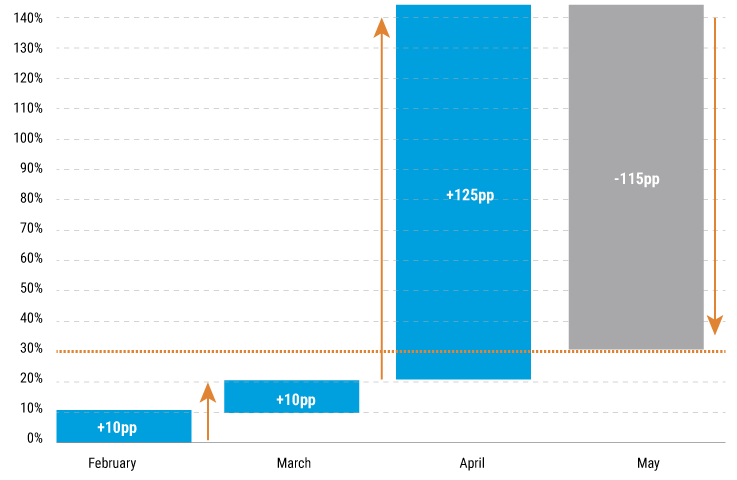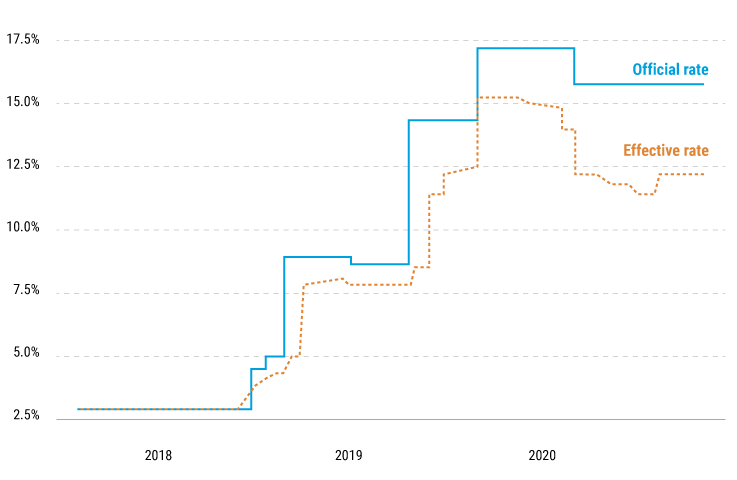What the ‘Tariff Ceasefire’ Means for the Global Economy

Alfonso de la Torre
Sovereign Analyst, Emerging Markets Fixed Income

The US and China have agreed to deescalate their tit-for-tat trade moves, lowering tariffs from former near-embargo levels to 30% and 10%, respectively, for a period of 90 days. Though the tariffs remain a headwind to growth, downside risks for the global economy have receded considerably.
The key macro question now is less about finding a ceiling for tariffs and more about finding a floor – that is, determining how much room still remains for additional easing.
The US and China choose de-escalation over decoupling
The “tariff ceasefire” between the US and China constitutes the third de-escalatory round since President Trump’s 2 April announcement, following a similar 90-day pause for other countries on 9 April and exemptions on electronics and other items announced weeks later. US Treasury Secretary Scott Bessent emphasized that neither economy is seeking to completely sever trade ties with each other – noting that the 90-day deadline could be extended to avoid such decoupling.
The recent negotiations yielded mutual reductions in tariffs of 115 percentage points, bringing the US trade-weighted average tariff down from roughly 15% (after accounting for recent product exemptions) to around 13%.1 This remains high by historical standards but is a significant improvement from the 2 April announcements, when trade-weighted tariffs peaked at approximately 22%.
Moving from “prohibitively high” to merely “high” tariffs will help the US economy avoid a more pronounced downturn, even if the current policy mix still constitutes a negative – though smaller – shock (see chart). Likewise, for China, de-escalation will be supportive for economic activity.
The US-China Tariff Ceasefire Comes After Months of Escalation
US official tariff on China (%)

Source: White House data, PineBridge calculations as of 12 May 2025.
Even as the US signals some willingness to unveil more sectoral tariffs (focusing on pharmaceuticals, for example), the overall trade-weighted tariff is likely to fall further. The market, economic, and political constraints that emerged after 2 April have reduced appetite for escalation.
Product exemptions and preferential treatment following bilateral negotiations (the recent quota on UK cars, for example) are also likely to expand over time. For example, during the first Trump administration, effective tariffs on China came down over time as more exemptions were granted (see chart).
Effective Tariffs Came Down During Trump 1.0 as Exemptions Were Granted
US tariff rate on imports from China (2017-2021); official vs. effective (%)

Source: Flaaen, Aaron, Kathryn Langemeier, and Justin Pierce (2021). "Factors Affecting Recent U.S. Tariffs on Imports from China," FEDS Notes. Washington: Board of Governors of the Federal Reserve System, February 17, 2021, https://doi.org/10.17016/2380-7172.2863.
Official US-China tariffs could also fall further. For Chinese engagement to continue, the incentive of additional relief will be necessary; despite recent US warnings, returning to tariffs exceeding 100% is unlikely. Thus, the 20% tariffs levied over February and March will be part of the discussions.
On the US side, the focus will be on purchase agreements (similar to those of the Phase 1 Deal under Trump 1.0) as well as some minor concessions on intellectual property and trademarks. China will probably hold the line when it comes to support for state-owned enterprises and foreign exchange policy, however.
In sum, we believe the current tariff rate is more likely to fall further than to rise after the 90 days are up. Our baseline view is that US trade policy will settle with a combination of country-level duties of 10%, sectoral tariffs of 25%, and various exemptions.
The Fed: data-dependent when data is not dependable
Following last week’s Federal Open Market Committee (FOMC) meeting, Chair Powell signaled that the central bank would take its time to assess the effect of tariffs in the data before making changes to its policy stance. With tariffs changing between meetings, “wait and see” will likely remain the Fed’s approach in June and July.
The tariff ceasefire renders the upcoming data releases less useful than before, as these will reflect the tariff shock at its worst. The gap between “soft” and “hard” data may even reverse, with the former improving as the latter worsens.
Moreover, with US-China talks as well as other bilateral negotiations likely to yield additional policy changes, the Fed will struggle to evaluate the scale of the trade shock, let alone its distribution across growth and inflation.
With policy headlines, and not economic data, driving the outlook, the Federal Reserve will likely stay on hold for longer – and both tariff de-escalation and a cautious Fed are good news for the US dollar. While regaining pre-April levels will be difficult, and some of the recent pullback in foreign appetite for US assets may persist, the fact that broad-based tariffs have peaked will limit downside risks for the currency.
What does this all mean for global economies? We believe the new trade picture still portends a slowdown in growth, but ultimately no recession.
For more investment insights on the impact of shifting tariff policies, see “Investing Amid Peak Uncertainty: A Cross-Asset-Class View.”
1 At the new tariff level of 30%, Chinese imports are still expected to contract by more than half. This explains why a reduction of 110 percentage points for China lowers the global trade-weighted average tariff by only 2 percentage points.
Disclosure
Investing involves risk, including possible loss of principal. The information presented herein is for illustrative purposes only and should not be considered reflective of any particular security, strategy, or investment product. It represents a general assessment of the markets at a specific time and is not a guarantee of future performance results or market movement. This material does not constitute investment, financial, legal, tax, or other advice; investment research or a product of any research department; an offer to sell, or the solicitation of an offer to purchase any security or interest in a fund; or a recommendation for any investment product or strategy. PineBridge Investments is not soliciting or recommending any action based on information in this document. Any opinions, projections, or forward-looking statements expressed herein are solely those of the author, may differ from the views or opinions expressed by other areas of PineBridge Investments, and are only for general informational purposes as of the date indicated. Views may be based on third-party data that has not been independently verified. PineBridge Investments does not approve of or endorse any republication of this material. You are solely responsible for deciding whether any investment product or strategy is appropriate for you based upon your investment goals, financial situation and tolerance for risk.


